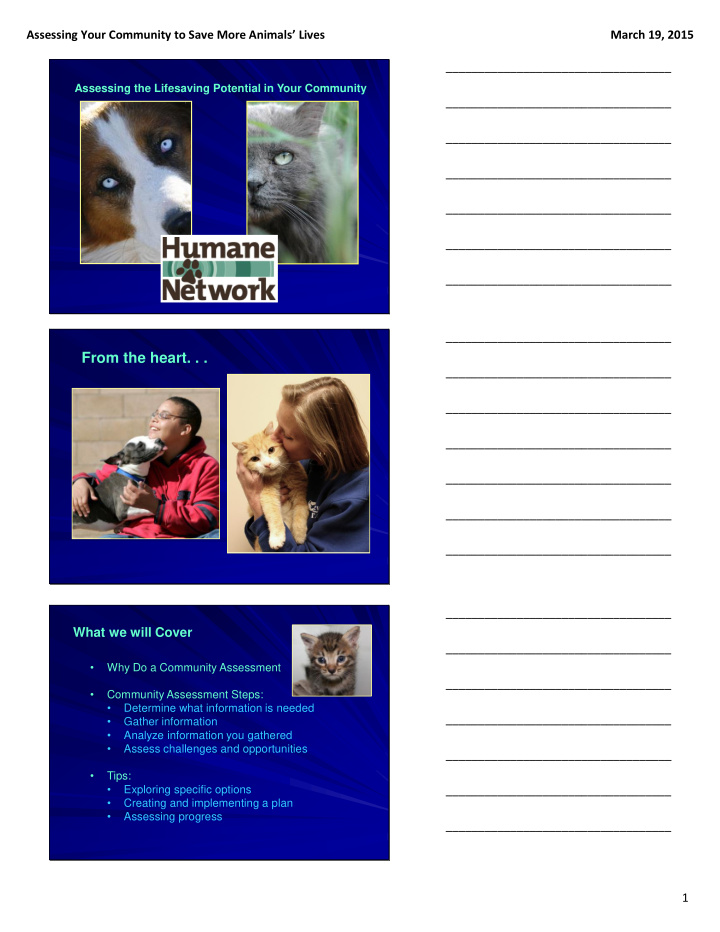



Assessing Your Community to Save More Animals ’ Lives March 19, 2015 ___________________________________ Assessing the Lifesaving Potential in Your Community ___________________________________ ___________________________________ ___________________________________ ___________________________________ ___________________________________ ___________________________________ ___________________________________ From the heart. . . ___________________________________ ___________________________________ ___________________________________ ___________________________________ ___________________________________ ___________________________________ ___________________________________ What we will Cover ___________________________________ • Why Do a Community Assessment ___________________________________ • Community Assessment Steps: • Determine what information is needed ___________________________________ • Gather information • Analyze information you gathered • Assess challenges and opportunities ___________________________________ • Tips: • Exploring specific options ___________________________________ • Creating and implementing a plan • Assessing progress ___________________________________ 1
Assessing Your Community to Save More Animals ’ Lives March 19, 2015 ___________________________________ Why do a Community Assessment ___________________________________ Benefits? ___________________________________ ___________________________________ ___________________________________ ___________________________________ ___________________________________ ___________________________________ Why do a Community Assessment ___________________________________ Benefits include: • Best use of resources ___________________________________ • Gather more resources/supporters: • Donors/foundations ___________________________________ • Government officials • Board of directors ___________________________________ • Shelter leadership • Media ___________________________________ • Public at large • Strategic focus for quicker results • Getting reluctant parties on board ___________________________________ ___________________________________ Why do a Community Assessment ___________________________________ Desired Outcomes? ___________________________________ ___________________________________ ___________________________________ Does it have to take a long time? ___________________________________ ___________________________________ 2
Assessing Your Community to Save More Animals ’ Lives March 19, 2015 ___________________________________ Determine What Information is Needed ___________________________________ • Geographic focus • Data ___________________________________ • Numbers of animals by meaningful categories • Services available ___________________________________ • Demographic information • Resources ___________________________________ ___________________________________ ___________________________________ ___________________________________ Determine What Information is Needed ___________________________________ • Why you should consider involving others? • Who needs to be involved? ___________________________________ ___________________________________ ___________________________________ ___________________________________ ___________________________________ ___________________________________ ___________________________________ Gathering Information: Where to obtain statistics? ___________________________________ • Ask shelter management • Websites • Annual Reports ___________________________________ • Formal shelter assessments • Public officials • Public Information Requests ___________________________________ • Governmental agencies • Organizations (Maddie’s Fund, ___________________________________ NAIA) Public vs. Private Institutions ___________________________________ 3
Assessing Your Community to Save More Animals ’ Lives March 19, 2015 ___________________________________ Gathering Information: What animal statistics are needed? ___________________________________ • Source of incoming animals: • Owner surrender ___________________________________ • Field/stray • Transferred animals (in and outside area separate) • Disposition of animals: ___________________________________ • Adoption • Transfer (in and outside area separate) • Return to owner (RTO) ___________________________________ • Return to Field (RTF, SNR, TNR) • Euthanasia • Lost or died in shelter, and “unknown” ___________________________________ • Incoming and disposition by: • Species • Age ___________________________________ • Zip code of origin • By month ___________________________________ Gathering Information: ___________________________________ What animal statistics are needed? • Surrender reasons — valuable in helping to identify ___________________________________ needs • Average length of stay ___________________________________ • Euthanasia reason • Space • Temperament ___________________________________ • Health • Feral • Other ___________________________________ ___________________________________ ___________________________________ ___________________________________ Gathering Information: What animal statistics are ___________________________________ needed? It’s important to identify : ___________________________________ • Unique animals. Some animals could be counted twice if transferred from one agency to another. ___________________________________ • Animals from outside of the designated area. ___________________________________ ___________________________________ 4
Assessing Your Community to Save More Animals ’ Lives March 19, 2015 ___________________________________ Gathering Information: What animal statistics are needed? ___________________________________ There is no standard statistical reporting methodology • Asilomar Accords (community matrix to classify animals) ___________________________________ • National Federation of Humane Societies ___________________________________ • Save Rate • Live Release Rate ___________________________________ • Statistics per 1,000 residents (admissions, adoptions, deaths) Benefits and drawbacks to each method ___________________________________ “Noses in, noses out” – Brenda Barnette ___________________________________ ___________________________________ Gathering Information: What animal statistics are needed? ___________________________________ There is no national repository of information ___________________________________ • Shelter Animals Count – recent effort • Maddie’s Fund ___________________________________ • National Animal Interest Alliance Shelter Project • Regional data/reports such as: ___________________________________ • California Sheltering Report • Denver Metro Animal Coalition ___________________________________ • Some states’ Department of Agriculture or State Veterinarian ___________________________________ ___________________________________ Gathering Information: ___________________________________ What other information is needed? Resources at the disposal of each agency ___________________________________ • Non-profit - IRS Form 990 • GuideStar ___________________________________ • Charity Navigator • National Animal Interest Alliance Shelter Project ___________________________________ • Government-funded facilities • Contracted or government run • Online or request budget ___________________________________ • Facility capacity and average occupancy levels ___________________________________ • Staffing levels 5
Recommend
More recommend